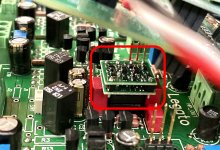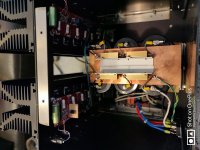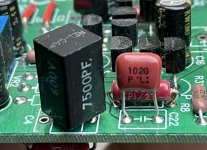So you’re saying: don’t hold out, get the Mercury? 
It’s pretty hard actually to find Legato reviews or measurements even when Mercury wasn’t around. Those I do find tend to say they sound very musical and balanced. Subjective of course. I read the IVY measures better but have yet to find the measurements.
Theoretically the discrete transistor approach should work really well — in practice depending on the implementation of course. High linearity and bandwidth.
It’s pretty hard actually to find Legato reviews or measurements even when Mercury wasn’t around. Those I do find tend to say they sound very musical and balanced. Subjective of course. I read the IVY measures better but have yet to find the measurements.
Theoretically the discrete transistor approach should work really well — in practice depending on the implementation of course. High linearity and bandwidth.
Sorry I misread. I thought you said the Legato sounded terrible but see now that you were talking about the buffer. Just the headphone out or also the unbalanced out?
Also I am now assuming you like the Legato or would have finished the Mercury otherwise
Thanks and still curious if the Legato will be restocked.
Also I am now assuming you like the Legato or would have finished the Mercury otherwise
Thanks and still curious if the Legato will be restocked.
Sorry I misread. I thought you said the Legato sounded terrible but see now that you were talking about the buffer. Just the headphone out or also the unbalanced out?
Whoaaa. Before addressing this... Quoting from above, "But I have lots of DACs Including PS Audio Direct Stream which I prefer." That DAC got this review and its test performance earned it a rank of #161 out of a total of 171 products. There is lots of room here for individual opinions, which I quite support and respect. But lets add another data point concerning the Legato, and contrast it to Mercury.
I've used every version of Legato, and am now in the finishing stages of (Santa's workshop) builds using Mercury with both 9018 and ES Pro Buffalo 3s. I have always rolled caps with the Legatos, and they drive balanced amps and speakers in my main system. My own copy of the new DAC with the Mercury will be for monitoring track mixing with multiple detailed sound layers, mostly for video. I've directly compared the I/V output of both using the same sources and the same headphones (Sennheiser HD600) within the same 10 minute span.
Firstly, for 300 ohm headphones, the Legato output buffers are a big help. I can't see a down-side. By design, a balanced output typically sounds better, but single-ended outs via buffers are very respectable with both Legato and Mercury.
Second, whether balanced or SE, the sound 'signature' of the two is slightly different even though both are quite high resolution. The Mercury sounds a bit more 'coherent' or maybe 'controlled' while the Legato (w/ tweaked caps) is a bit more 'engaging' and to my ears 'musical'. I am quite happy with both, and think my two different applications play to the strengths of each.
Lastly, I think the Legato is the better choice for a 9028 if you want to slightly adjust the sound with tweaks. If you're running the 9038, I'm not so sure that applies. [I don't recall reading about anybody using Legato with the 9038.] On the topic of Legato tweaks, this morning I finally did something that I had planned to do a long time ago. I swapped the stock dual opamp for a discrete opamp from Sparkos. Its a tight fit but the pins do fully engage and there is just enough overhead space by adding a washer to the DAC standoffs. First thing I noticed was that the no-signal background clearly dropped a notch. The elements of great voices and instruments are easy to enjoy, and I noticed no fatigue at higher levels for extended times. Yes, $80 is an expensive opamp. But if you use single ended output from a Legato along with other gear that is highly resolving, that may be a cheap upgrade.
Cheers and stay safe,
Frank
Attachments
Last edited:
Frank, that's great feedback, thanks.
Your subjective findings would match the technical prowess of both boards. The Mercury with its error amp should be spot-on but perhaps also more analytical. The Legato may have a bit more distortion (harmonics) but this may actually be pleasing to the ear. All a matter of preference.
The build I'm planning would feed into a fully discrete, 2-board AMB β22 amp. There's a great appeal to me (call it dogma) to having the entire analog chain in discrete class A. No op-amp rolling necessary. So when earlier Brian responded to me by e-mail saying the Legato's should be back in stock in a few days, a Legato build is what I'm considering.
When I say no opamps, that means going balanced out into an unbalanced amp. Also with DC offset into a DC-coupled amp. So as interstage I'm thinking of doing a 10K:10K input transformer. Matched to a 10K volume pot. The transformer having the benefit of negating the DC offset on the amp's end, and accepting both balanced and unbalanced inputs.
Which caps have you rolled and with what?
Your subjective findings would match the technical prowess of both boards. The Mercury with its error amp should be spot-on but perhaps also more analytical. The Legato may have a bit more distortion (harmonics) but this may actually be pleasing to the ear. All a matter of preference.
The build I'm planning would feed into a fully discrete, 2-board AMB β22 amp. There's a great appeal to me (call it dogma) to having the entire analog chain in discrete class A. No op-amp rolling necessary. So when earlier Brian responded to me by e-mail saying the Legato's should be back in stock in a few days, a Legato build is what I'm considering.
When I say no opamps, that means going balanced out into an unbalanced amp. Also with DC offset into a DC-coupled amp. So as interstage I'm thinking of doing a 10K:10K input transformer. Matched to a 10K volume pot. The transformer having the benefit of negating the DC offset on the amp's end, and accepting both balanced and unbalanced inputs.
Which caps have you rolled and with what?
Which caps have you rolled and with what?
https://www.diyaudio.com/forums/twisted-pear/183663-legato-3-look-ma-caps-59.html#post4585656
A generation earlier - board version 2 - I had nice ceramics in C19-22 and it was very pleasing. But for the version 3 boards I couldn’t find that particular cap so went with what I described. I have generally used non-kit “fancy” resistors for 1-4 and 9-16 but I don’t think they are lower noise than the Vishay that Brian sends. That’s more about “audiophile angst”, and part of the fun of DIY. 
Enjoy!
Enjoy!
Attachments
I have used the legato iv with my b3se dac. I have managed to improve a bit the sound and lower the thd by replacing QN1 and QN4 with some tl431(1.25v) adjustable voltage reference. Using a trimmer I was able to set 1.8v at iv inputs.
The mercury iv has a servo that does this job and is also dc coupled, for me mercury sounds better and also measures better. I ended selling the legato and kept the mercury.
Recently I have purchased a ready made dac and have for sale the b3se dac, the mercury iv and also some power supplies.
If interested we can find a workaround.
The mercury iv has a servo that does this job and is also dc coupled, for me mercury sounds better and also measures better. I ended selling the legato and kept the mercury.
Recently I have purchased a ready made dac and have for sale the b3se dac, the mercury iv and also some power supplies.
If interested we can find a workaround.
Hmmm...
As I recall, some measurements were posted with the Legato (balanced output). The highest harmonic was the 3rd at about -120 dB, not very audible, if at all. The subjective sound quality is probably not related to the distortion harmonics.
Frank, that's great feedback, thanks.
Your subjective findings would match the technical prowess of both boards. The Mercury with its error amp should be spot-on but perhaps also more analytical. The Legato may have a bit more distortion (harmonics) but this may actually be pleasing to the ear. All a matter of preference.
The build I'm planning would feed into a fully discrete, 2-board AMB β22 amp. There's a great appeal to me (call it dogma) to having the entire analog chain in discrete class A. No op-amp rolling necessary. So when earlier Brian responded to me by e-mail saying the Legato's should be back in stock in a few days, a Legato build is what I'm considering.
When I say no opamps, that means going balanced out into an unbalanced amp. Also with DC offset into a DC-coupled amp. So as interstage I'm thinking of doing a 10K:10K input transformer. Matched to a 10K volume pot. The transformer having the benefit of negating the DC offset on the amp's end, and accepting both balanced and unbalanced inputs.
Which caps have you rolled and with what?
As I recall, some measurements were posted with the Legato (balanced output). The highest harmonic was the 3rd at about -120 dB, not very audible, if at all. The subjective sound quality is probably not related to the distortion harmonics.
There's a great appeal to me (call it dogma) to having the entire analog chain in discrete class A. No op-amp rolling necessary.
It just occurred to me - the Sparkos discrete opamp that I put in (for headphone use only in my case) is set up for class A output, and will supposedly drive up to ~3.5v before gain is decreased. So it might compete favorably with a transformer solution and remain within your preferred dogma.
A generation earlier - board version 2 - I had nice ceramics in C19-22 and it was very pleasing. But for the version 3 boards I couldn’t find that particular cap so went with what I described. I have generally used non-kit “fancy” resistors for 1-4 and 9-16 but I don’t think they are lower noise than the Vishay that Brian sends. That’s more about “audiophile angst”, and part of the fun of DIY.
Great stuff guys, thanks.
As I recall, some measurements were posted with the Legato (balanced output). The highest harmonic was the 3rd at about -120 dB, not very audible, if at all. The subjective sound quality is probably not related to the distortion harmonics.
Oh wow. At those numbers it's academic really.
I have used the legato iv with my b3se dac. I have managed to improve a bit the sound and lower the thd by replacing QN1 and QN4 with some tl431(1.25v) adjustable voltage reference. Using a trimmer I was able to set 1.8v at iv inputs.
The mercury iv has a servo that does this job and is also dc coupled, for me mercury sounds better and also measures better. I ended selling the legato and kept the mercury.
Recently I have purchased a ready made dac and have for sale the b3se dac, the mercury iv and also some power supplies.
If interested we can find a workaround.
I'll send you a PM.
It just occurred to me - the Sparkos discrete opamp that I put in (for headphone use only in my case) is set up for class A output, and will supposedly drive up to ~3.5v before gain is decreased. So it might compete favorably with a transformer solution and remain within your preferred dogma.Analog volume? I still love the Twisted Pear relay-driven stepped attenuator. It sounds great and is lovably funky.
That's a great suggestion! I'll give it some serious thought. You got me on my class A vibe for this build
Downside: paraphrasing Bruno Putzeys, "never waste a good balanced input". Having an input transformer provides much higher CMRR and so dynamic range. Though that too, is something of a numbers game with a short, quality interconnect.
Also I did consider the Joshua Tree. And read about the funky rickety-tack of the relays
- I want to do volume control in the pre-amp and run the DAC at maximum level, for flexibility with multiple inputs and an optimal dynamic range. The b22 runs dual mono +/- 18V and feeding another power supply just for volume feels kind of out of balance, complexity vs. functionality.
- Going the transformer route, I want to present an impedance matched load and do away with any damping networks. The Joshua Tree and the like would have a varying Z.
- All in all it's quite the bit of money. So I'm thinking, let's put that into a great pot instead. I'm eyeing a DACT CT2-10K-2.
It just occurred to me - the Sparkos discrete opamp that I put in (for headphone use only in my case) is set up for class A output, and will supposedly drive up to ~3.5v before gain is decreased. So it might compete favorably with a transformer solution and remain within your preferred dogma.
When placing the Sparkos -- was there enough height clearance to still stack the Buffalo on the Legato? Or did you have to place them side-to-side and connect them with e.g. a ribbon cable?
If you look at the attachment in post #665, you will notice the tall black rectangular polystyrene caps toward the left side. To fit them I used 16mm standoffs between boards plus longer header pins (visible in front). There was clearance for the opamp at 16mm, but just for a bit more safety I added a ~1mm nylon washer to the standoffs. If you are working with a Legato already having shorter pins, its easy to heat the short end of each pin and pull the long end out through the black plastic strip. If you're starting with a new board, Brian can add the longer header, maybe taller standoffs too. I certainly would not add a significant lengh of wire. Adjusting the stack height is much better.
As I was listening through the discrete op amp last time, I decided the PCM files sound significantly closer to DSD - that's the kind of effect it has, if it's one you might like.
As I was listening through the discrete op amp last time, I decided the PCM files sound significantly closer to DSD - that's the kind of effect it has, if it's one you might like.
Last edited:
Thanks -- not sure how I missed that  So I'm now set on going this discrete opamp route, thanks for pointing me in this direction. I'd be doing a new Legato build.
So I'm now set on going this discrete opamp route, thanks for pointing me in this direction. I'd be doing a new Legato build.
The PCB is completely through-hole with solder pads on both sides, right? Getting creative I'm thinking I could even solder the caps on the back side. Who knows that could even make a dual SS2590 fit.
Have also been looking at a Staccato OSH. Said to sound less analytical, more natural than the Sparkos. But seeing how these are oriented vertically, with heatsinks attached, I'm thinking that might be a bit too much trouble.
The PCB is completely through-hole with solder pads on both sides, right? Getting creative I'm thinking I could even solder the caps on the back side. Who knows that could even make a dual SS2590 fit.
Have also been looking at a Staccato OSH. Said to sound less analytical, more natural than the Sparkos. But seeing how these are oriented vertically, with heatsinks attached, I'm thinking that might be a bit too much trouble.
Thanks -- not sure how I missed thatSo I'm now set on going this discrete opamp route, thanks for pointing me in this direction. I'd be doing a new Legato build.
If you are like me and enjoy tinkering for ultimate "sonic engagement", then Legato is a great choice.
The PCB is completely through-hole with solder pads on both sides, right? Getting creative I'm thinking I could even solder the caps on the back side. Who knows that could even make a dual SS2590 fit.
Yes, I have placed numerous components below the board where you are free to use whatever height standoffs you like. If you move the red Wima caps (#17-18) to the bottom, then there is ample room for the SS3602. Space for a dual SS2590 would probably require soldering the base adaptor directly to the Legato - no DIP8 socket. Even then, according to online mechanical drawings, the adaptor is 16 mm high plus you would need about another 5 mm on top. Also there remains the question of how much heat you are producing right under the DAC chip above.
Have also been looking at a Staccato OSH. Said to sound less analytical, more natural than the Sparkos. But seeing how these are oriented vertically, with heatsinks attached, I'm thinking that might be a bit too much trouble.
I suppose there is another possibility. You could route the pins from the Buffalo out the 'bottom' of Legato
Whatever you decide, you *must* report back and include pictures!
Enjoy your interesting and challenging project!
Frank
- Status
- This old topic is closed. If you want to reopen this topic, contact a moderator using the "Report Post" button.
- Home
- More Vendors...
- Twisted Pear
- Legato 3 - Look ma! No caps!


